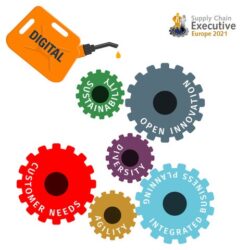Chief supply chain officers must pull the right strategic levers

Today’s supply chain executives are facing an extremely difficult agenda, with a high urgency to act. The ongoing turmoil in global supply chains, due to all kinds of shortages, is screaming out for more resilience. At the same time, companies are being forced to strengthen their commitment to truly sustainable supply chains. And to what extent is digitalization providing the necessary lubrication to keep the various cogs of business turning smoothly? As part of its annual research for the Top 28 Supply Chain Executives in Europe ranking, Supply Chain Media interviewed supply chain leaders on the list to learn more.
By Martijn Lofvers, Onno Beijers, Johan Smits, Edwin Tuyn, Oskar Verkamman and Christian Plesca
When asked about the three most urgent topics on their agenda, all the supply chain executives were united in their answers: resilience, sustainability and digitalization. Supply chains have to become more resilient because of the different kinds of disruptions and the ongoing shortages in materials and people. In the USA, the so-called ‘Great Resignation’ is underway: millions of Americans are quitting their jobs because the lockdowns made them realize that they want to work less, or at least differently. Besides the ageing population and large-scale retirement, this is one of the reasons for the labour shortage. Meanwhile, the labour shortage in the UK has been exacerbated by Brexit, which forced thousands of truck drivers and warehouse operatives from Eastern Europe to return to their home countries.
In parallel, the sustainability agenda is more important than ever. As a result, companies need to rethink their future supply chain set-up. A handful of supply chain executives mentioned that their companies have done a lot in terms of sustainability, but have now hit a ceiling and are struggling to make further improvements. Cross-industry collaboration will definitely be required to force the necessary breakthrough, said one of the top-ranking executives.
Another executive stated during the interview that digitalization should not be an end in itself, but should instead be aimed at improving existing business models – by standardization – and enabling new ones. Two top-ranking executives urged their peers to share their practical experiences with supply chain start-ups and scale-ups in order to keep the pace of innovation high. Another chief supply chain executive stressed that a new kind of leadership is required to pull the right levers within the complex company system to activate the interlocking cogs.
Assessing supply chain leaders
In order to assess the strategic performance of European supply chain executives, Supply Chain Media, global advisory company KPMG and executive recruitment agency Inspired-Search have jointly compiled the seventh edition of the Top 28 European Supply Chain Executives in Europe. This ranking is based on four dimensions: financial company performance, personal responsibility, personal visibility and peer votes. In addition, to be included in the list, executives must have been in their current position for at least a year.
In today’s world, companies are facing significant business challenges. So how has this impacted the financial performance of the leaders this year? Beside disruptions caused by the pandemic, the behaviour of customers and consumers is changing, traditional channels are moving towards e-commerce and an omnichannel approach, and all this is increasing the pressure on operational excellence and logistics costs.
To analyse the financial performance this year, Supply Chain Media and global advisory company KPMG used several financial calculations accompanied by a check on ESG ratio scores. Given the massive supply chain fluctuations during the pandemic and the severe shortages in the second half of 2021, the Return On Capital Employed (ROCE) was earmarked as the most crucial key performance indicator (KPI) this year. More than any other KPI, ROCE indicates the agility and responsiveness to execute the supply chain planning whilst sustaining efficiency.
Dominating the ranking
A few sectors clearly dominate the ranking in this post-pandemic era, namely pharmaceutical, biotechnology and life sciences companies (and especially Pfizer). Besides that, home consumption and increased discretionary spending have catapulted consumer packaged goods companies into the spotlight. Perhaps unsurprisingly, the Top 28 companies saw a smaller decrease in their profits compared to the larger set of companies in the Top 100. One reason for this could be that the operational efficiency of these Top 28 supply chain leaders enables them to adapt to the pandemic-related challenges more quickly.
To arrive at the final Top 28, the companies’ Environmental, Social and Governance (ESG) scores were sense-checked. There were hardly any differences between the ESG scores (consisting of the direct emissions from owned or controlled sources plus indirect emissions from the generation of purchased energy) of the various top-ranking companies. To achieve a clear comparison on sustainability, the Scope 3 emissions ratios – including all indirect emissions occurring in a company’s value chain – have been included in the analysis for the Top 28.










